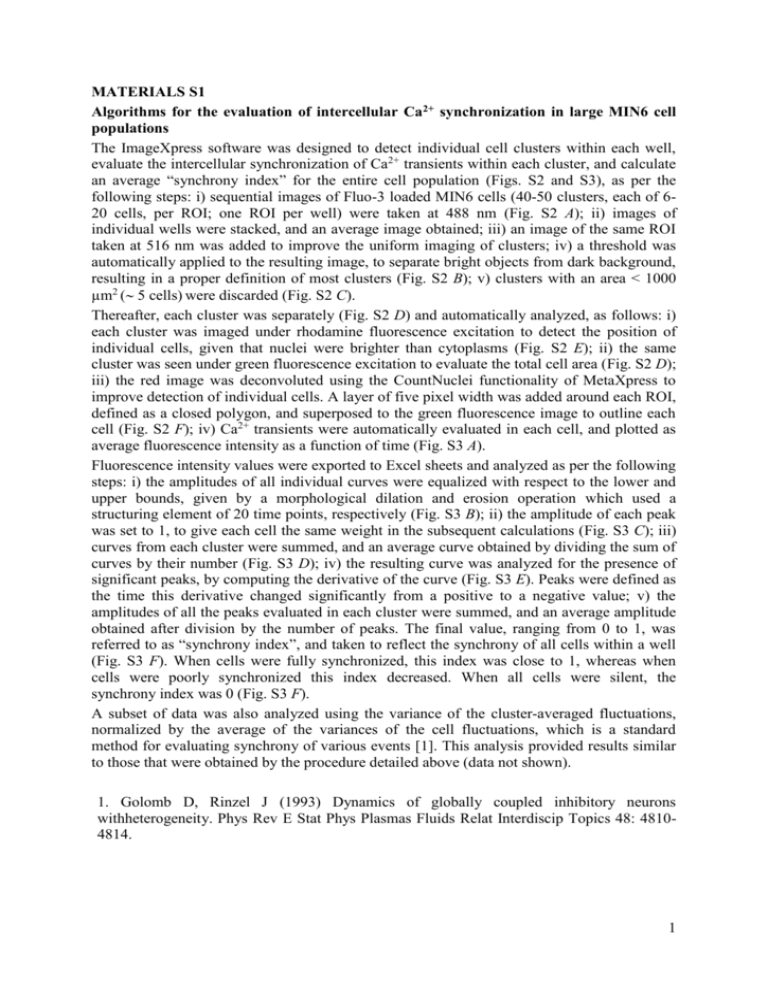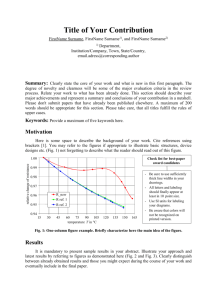Supporting Methods:
advertisement

MATERIALS S1 Algorithms for the evaluation of intercellular Ca2+ synchronization in large MIN6 cell populations The ImageXpress software was designed to detect individual cell clusters within each well, evaluate the intercellular synchronization of Ca2+ transients within each cluster, and calculate an average “synchrony index” for the entire cell population (Figs. S2 and S3), as per the following steps: i) sequential images of Fluo-3 loaded MIN6 cells (40-50 clusters, each of 620 cells, per ROI; one ROI per well) were taken at 488 nm (Fig. S2 A); ii) images of individual wells were stacked, and an average image obtained; iii) an image of the same ROI taken at 516 nm was added to improve the uniform imaging of clusters; iv) a threshold was automatically applied to the resulting image, to separate bright objects from dark background, resulting in a proper definition of most clusters (Fig. S2 B); v) clusters with an area < 1000 µm2 ( 5 cells) were discarded (Fig. S2 C). Thereafter, each cluster was separately (Fig. S2 D) and automatically analyzed, as follows: i) each cluster was imaged under rhodamine fluorescence excitation to detect the position of individual cells, given that nuclei were brighter than cytoplasms (Fig. S2 E); ii) the same cluster was seen under green fluorescence excitation to evaluate the total cell area (Fig. S2 D); iii) the red image was deconvoluted using the CountNuclei functionality of MetaXpress to improve detection of individual cells. A layer of five pixel width was added around each ROI, defined as a closed polygon, and superposed to the green fluorescence image to outline each cell (Fig. S2 F); iv) Ca2+ transients were automatically evaluated in each cell, and plotted as average fluorescence intensity as a function of time (Fig. S3 A). Fluorescence intensity values were exported to Excel sheets and analyzed as per the following steps: i) the amplitudes of all individual curves were equalized with respect to the lower and upper bounds, given by a morphological dilation and erosion operation which used a structuring element of 20 time points, respectively (Fig. S3 B); ii) the amplitude of each peak was set to 1, to give each cell the same weight in the subsequent calculations (Fig. S3 C); iii) curves from each cluster were summed, and an average curve obtained by dividing the sum of curves by their number (Fig. S3 D); iv) the resulting curve was analyzed for the presence of significant peaks, by computing the derivative of the curve (Fig. S3 E). Peaks were defined as the time this derivative changed significantly from a positive to a negative value; v) the amplitudes of all the peaks evaluated in each cluster were summed, and an average amplitude obtained after division by the number of peaks. The final value, ranging from 0 to 1, was referred to as “synchrony index”, and taken to reflect the synchrony of all cells within a well (Fig. S3 F). When cells were fully synchronized, this index was close to 1, whereas when cells were poorly synchronized this index decreased. When all cells were silent, the synchrony index was 0 (Fig. S3 F). A subset of data was also analyzed using the variance of the cluster-averaged fluctuations, normalized by the average of the variances of the cell fluctuations, which is a standard method for evaluating synchrony of various events [1]. This analysis provided results similar to those that were obtained by the procedure detailed above (data not shown). 1. Golomb D, Rinzel J (1993) Dynamics of globally coupled inhibitory neurons withheterogeneity. Phys Rev E Stat Phys Plasmas Fluids Relat Interdiscip Topics 48: 48104814. 1









